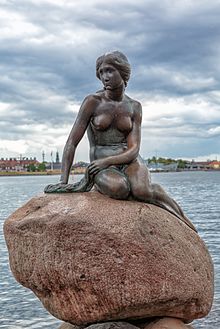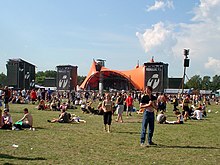Tourism in Denmark

The tourism in Denmark is characterized in large part by holiday homes and camp sites . A significant part of tourism takes place on the coasts, as the country has a coast that is comparatively long for its size. In 2007 over 45 million overnight stays were counted.
traffic
In Denmark it is mandatory to wear seat belts , even during the day you have to drive with low beam . The maximum speed is 50 km / h in urban areas, 80 km / h outside and on expressways and 130 km / h on motorways. For cars and motorcycles with trailers / caravans, trucks and buses, a maximum speed of 50 km / h applies in urban areas (even if the local signs allow a higher speed), in out-of-town areas of 70 km / h and on highways of 80 km / h. The alcohol limit is 0.5. The Danish tourist office VisitDenmark provides information on Danish traffic regulations on its website (see links) and the various automobile clubs.
Transport links
A dense network of ferries and bridges connects the Danish islands, so that traveling from island to island can also be a holiday experience, especially since each island has its own landscape.
- Road connections on the German-Danish border near Flensburg
- Federal Highway A 7 ( Jutland line ) which, when Harrislee extends to the border in the direction of Denmark, and as European route 45 in the direction Kolding continues
- Federal Highway 200 , as the bypass through the urban area of the border at Flensburg Kruså leads
- Important bridges
- Storebælt Bridge over the Great Belt from Funen to Zealand (toll)
- Oresund Bridge near Copenhagen over the Oresund to Sweden (toll)
- Two bridges ( Den gamle and Den nye Lillebæltsbro ) at Middelfart (near Kolding ) from Jutland to Funen
- Important ferry connections
- Via the A1 / B207 from Fehmarn to Rødbyhavn on Lolland , the Vogelfluglinie
- via the A19 from Warnemünde to Gedser on Falster
- via the Danish Primærrute 8 (Kruså - Sønderborg ) from Fynshav (Alsen) to Bøjden (Fyn)
- over the Danish Primærrute 9 from Spodsbjerg ( Langeland ) to Tårs (Lolland)
- via the Danish Primærrute 6 ( Roskilde ) from Helsingør over the Öresund to the Swedish Helsingborg
- Tunnel connection
- It is planned to build an 18 kilometer long immersed tunnel between Puttgarden on the Schleswig-Holstein island of Fehmarn and the Danish Rødby on Lolland . This should reduce the travel time between Hamburg and Copenhagen to around 3 hours. The Danish Parliament approved the proposal in February 2011, and work should start in 2014 and be completed in 2020. The project is very controversial on the island of Fehmarn. Denmark wants to finance the construction costs estimated at 5.1 billion euros alone. For the German side, there are connection costs on land, which are officially estimated at 800 million euros. According to the Federal Audit Office, they could rise to 1.7 billion euros.
Destinations
The Danish South Sea , the area in the Baltic Sea around the two largest Danish islands, Zealand and Funen, is equally popular with sailors and campers . Denmark's beautiful coastlines with long white beaches on the North Sea and Skagerrak and the sometimes somewhat stony ones on the Baltic Sea are also popular, all of which are freely accessible without tourist tax and the interesting cities with many sights, museums and historical buildings.
Information about travel routes and sights can be found on the website of the Danish tourist office VisitDenmark (see web links), on site in the tourist offices (Turistbureau, registration number: i ) and at the various automobile clubs. In addition, there are numerous travel guides about Denmark in German, which are available in bookshops or online shops. VisitDenmark's German headquarters are located in Hamburg .
towns and places
- Aalborg : a city on the Limfjord with a seaport, the Aalborg Castle (Ålborghus), the Holy Spirit Monastery from 1437 and excavations in what is now an urban area of a settlement over 1000 years old
- Aarhus with the open-air museum Den Gamle By (the old town), the cathedral at Aarhus with a high altar by Bernt Notke , the ARoS Aarhus art museum , the port of Aarhus and much more
- Billund , a world for children is the Legoland amusement park
- Helsingør with the harbor of Helsingør and the Kulturværftet , Marienlyst Castle and the world heritage site Kronborg Castle
- Hirtshals : The North Sea Oceanarium with the largest seawater aquarium in Europe is located in Hirtshals Havn .
- Jelling : with its rune stones (world cultural heritage) of the old Danish kings Gorm and Harald Blauzahn
- Copenhagen , the capital on Öresund with the amusement park Tivoli , the old port Nyhavn , the Rådhuspladsen and the landmark The Little Mermaid
- Odense , the birthplace of Denmark's most famous poet and writer Hans Christian Andersen
- Ribe , one of the oldest cities in Denmark, with a well-preserved old town ( Ribe Cathedral from 1130 , town hall and Dominican monastery from the 13th to 15th centuries)
- Roskilde : Roskilde Cathedral (World Heritage Site) and the Roskilde Festival
- Sønderborg with its museums and old buildings is characterized by an exceptionally beautiful location at the entrance of the Alsensund into the Flensburg Fjord . The Düppeler Mühle and the Düppeler Schanzen battlefield are on the outskirts
- Skagerrak , the northern tip of Jutland with the impressive shifting dune Råbjerg Mile and wide beaches that can be used by cars
- Skagen : at the headland of Grenen , the Baltic Sea and the North Sea meet with the Kattegat and Skagerrak . The Skagens Museum houses around 1,900 impressionist works by the Skagen painters' group .
Baltic Sea
The coastline on the Baltic Sea is, due to the islands and fjords , much longer than that of the North Sea. Here you will find many, sometimes smaller, campsites and holiday home areas close to the beach. The tide-free beaches often border meadows, forests or cliffs and are sometimes a bit stony.
Important islands:
- Alsen (Danish Als) with the main town Sonderburg on the Flensburg Fjord . The industrial museum Danfoss in Nordborg is well worth a visit
- Ærø , particularly idyllic and typically Danish. Car ferry connections from Als, Fyn and Langeland
- Bornholm , mild climate and many prehistoric monuments, with ferry connections from Ystad and Sassnitz
- Falster with long beaches near Marielyst, car ferry connection from Gedser to Rostock
- Funen the second largest Danish island with Odense (Denmark's third largest city)
- Langeland , interesting because of a number of prehistoric monuments
- Lolland , the flat island with significant forests, is part of the bird flight route. There are prehistoric monuments of special rank
- Lyø , idyllic island with one of the most beautiful villages in Denmark
- Møn , known for the steep chalk coast of Møns Klint
- Zealand , the largest Danish island with the capital Copenhagen, can be reached via the Vogelfluglinie or the Storebælt Bridge. With the international airport of Copenhagen and the ferry and bridge connection to Sweden, the Öresund region is the metropolitan region of Denmark
North Sea

There are many holiday homes and, in some cases, large campsites along the entire North Sea coast with its wide beaches that are accessible by cars.
Important islands:
- Fanø , the northernmost of the Danish Wadden Sea Islands, can be reached by ferry from the industrial and port city of Esbjerg . The very wide sandy beach and wide dunes stretch along the entire west coast. The island is heavily influenced by tourism.
- Rømø is also one of the Danish Wadden Sea Islands and can be reached via the toll-free Rømødæmningen ( German : Rømø dam , length: 9170 m) from mainland Jutland or by ferry from Sylt . There are many holiday homes in different price ranges and some hotels.
to eat and drink
Specialties include beer ( Carlsberg , Tuborg or Faxe ), the typical red sausages ( rød pølse ), the national dish Smørrebrød , red grits , hot dogs or fish dishes (for example gravlax ).
currency
The Danish currency is the Danish Krone (DKK or outdated DKr; 1 Krone = 100 Øre ). It is tied to the euro with a fluctuation range of ± 2.25 percent .
Exchange rate:
- 1 EUR = 7.44 DKK
- 1 DKK = 0.134 EUR
The purchasing power of the euro in Denmark is 0.78 (May 2009). For vacationers, that means living more expensive. Since this value is calculated using the shopping cart , it only applies to a limited extent to items for everyday use.
The smallest coin is the 50 Øre piece. Prices can also amount to parts thereof and are rounded up or down for cash payments, but are calculated precisely to the Øre for credit card payments. Since October 1st, 2008, the 25-Øre piece no longer exists. All shops no longer accept the 25-Øre piece, but you could still return your 25-Øre pieces to the bank until 2011.
Curiosities
An advertising campaign by Visit Denmark in 2009 caused a sensation , in which a Danish woman named Karen was supposed to encourage tourism by promoting the allegedly easy willingness of Danish women to have a one-night stand without a condom.
Web links
- Official website of the Danish Tourist Office
- 1001 fortællinger om Danmark (German: 1001 Stories about Denmark ) Website of the Kulturarvsstyrelsen about the country's cultural assets (Danish, English)
Individual evidence
- ↑ Statbank Denmark (Danish statistical office)
- ↑ www.visitdenmark.com - All you need to know about traffic in Denmark
- ↑ International comparison of consumer prices. (PDF) Article number: 2171000091054. (No longer available online.) Federal Statistical Office, Wiesbaden 2009, formerly in the original ; Retrieved July 5, 2009 . ( Page no longer available , search in web archives ) Info: The link was automatically marked as defective. Please check the link according to the instructions and then remove this notice.
- ↑ Stern .de: Fast sex should attract vacationers , September 14, 2009






